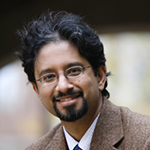For most of us, being healthy is more than lack of disease. It is a state of physical and mental well-being.

But what is well-being? Can a comprehensive picture of well-being be established? And how can a deeper understanding of the nature of well-being help further its measurement?
Ramesh Raghavan, MD, PhD, associate professor at the Brown School at Washington University in St. Louis, and Anna Alexandrova, PhD, a philosopher of science at Cambridge University, attempt to tackle those questions in a recent paper titled “Toward a Theory of Child Well-Being.”
Assuring the well-being of children is a stated goal of federal policy, and that of child-serving professionals. But while the attributes of well-being have been measured in different ways by different entities, there is little understanding of what exactly constitutes child well-being.
“We know what child well-being is about, but we don’t know what it is,” said Raghavan, also associate professor of psychiatry at Washington University School of Medicine in St. Louis.
“It’s much like the old Indian story of the blind men and the elephant,” he said. “The man who feels the tail thinks the elephant is like a rope. The man who feels the leg says it is like a pillar. We know the parts, we don’t have a grasp on the whole.”
In the paper, Raghavan and Alexandrova propose what they call a “Two Sources” theory of child well-being, and argue that child well-being is vitally important by itself, not just as a way station to future adult well-being.
The researchers propose two conditions in their theory. First, a child is considered to be doing well if that child develops capacities appropriate to his or her developmental stage that equip the child for successful adulthood, given the child’s social ecology. Second, that the child engages with the world in child-appropriate ways, such as curiosity and exploration, spontaneity and emotional security.
Raghavan and Alexandrova’s conceptualization is informing a national symposium on child well-being that the Brown School’s Policy Forum will host this November. The paper was discussed at a recent convening of the various community, academic, and foundation partners engaged in planning the symposium. Participants discussed how these ideas could inform the measurement of child well-being in the St. Louis region.
“Efforts to move the St. Louis region toward exemplary well-being for children are underway on a variety of fronts,” said Susan Stepleton, PhD, director of the Brown School’s Policy Forum. “Two things lacking have been a vehicle by which to describe theoretically what we mean by the term child well-being and a framework by which to measure it.
“The contribution of this paper will be extremely significant in tying together the collaborative threads and in allowing rigorous measurement that will unify the voices of child/youth advocates and provide convincing and persuasive evidence to policy-makers and financial supporters,” she said. “The paper’s impact will be profound.”